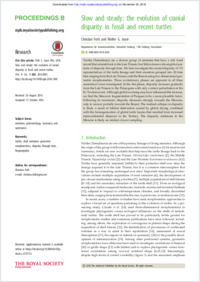Slow and steady : the evolution of cranial disparity in fossil and recent turtles
DOKPE
- Foth, Christian University of Fribourg
- Joyce, Walter G. University of Fribourg
- 2016
Published in:
- Proceedings of the Royal Society B. - 2016, vol. 283, no. 1843, p. 20161881
English
Turtles (Testudinata) are a diverse group of amniotes that have a rich fossil
record that extends back to the Late Triassic, but little is known about global patterns
of disparity through time.We here investigate the cranial disparity of 172
representatives of the turtle lineage and their ancestors grouped into 20 time
bins ranging from the Late Triassic until the Recent using two-dimensional geometric
morphometrics. Three evolutionary phases are apparent in all three
anatomical views investigated. In the first phase, disparity increases gradually
from the Late Triassic to the Palaeogene with only a minor perturbation at the
K/Textinct event. Although globalwarming may have influenced this increase,
we find the Mesozoic fragmentation of Pangaea to be a more plausible factor.
Following its maximum, disparity decreases strongly towards the Miocene,
only to recover partially towards the Recent. The marked collapse in disparity
is likely a result of habitat destruction caused by global drying, combined
with the homogenization of global turtle faunas that resulted from increased
transcontinental dispersal in the Tertiary. The disparity minimum in the
Miocene is likely an artefact of poor sampling.
record that extends back to the Late Triassic, but little is known about global patterns
of disparity through time.We here investigate the cranial disparity of 172
representatives of the turtle lineage and their ancestors grouped into 20 time
bins ranging from the Late Triassic until the Recent using two-dimensional geometric
morphometrics. Three evolutionary phases are apparent in all three
anatomical views investigated. In the first phase, disparity increases gradually
from the Late Triassic to the Palaeogene with only a minor perturbation at the
K/Textinct event. Although globalwarming may have influenced this increase,
we find the Mesozoic fragmentation of Pangaea to be a more plausible factor.
Following its maximum, disparity decreases strongly towards the Miocene,
only to recover partially towards the Recent. The marked collapse in disparity
is likely a result of habitat destruction caused by global drying, combined
with the homogenization of global turtle faunas that resulted from increased
transcontinental dispersal in the Tertiary. The disparity minimum in the
Miocene is likely an artefact of poor sampling.
- Faculty
- Faculté des sciences et de médecine
- Department
- Département de Géosciences
- Language
-
- English
- Classification
- Earth sciences
- License
- CC BY
- Open access status
- green
- Identifiers
- Persistent URL
- https://folia.unifr.ch/unifr/documents/312332
Statistics
Document views: 66
File downloads:
- Foth_Joyce_2016_The_Evolution_of_Cranial_Disparity_in_Turtles.pdf: 171
